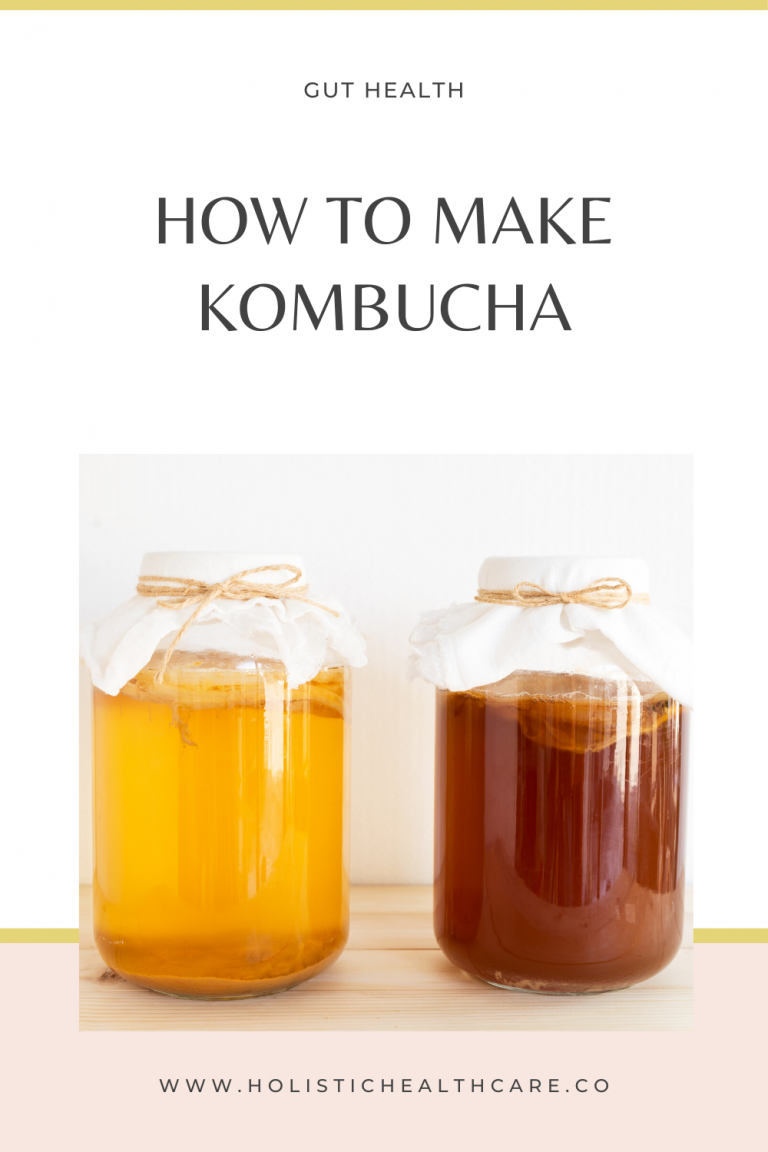
Learn about the history, health benefits of kombucha and how to make properly make it.
A word of caution – as with all fermented foods, you should start with small amounts and try one at a time. Not all fermented foods suit everyone. If you have active Small Intestinal Bacterial Overgrowth (SIBO) or lots of candida, it’s best you get on top of these conditions first before loading up with fermented foods. Many fermented foods are also prebiotics and some contain bad bacterias alongside the good ones. If there are excessive overgrowth of gut bacterias, feeding them more prebiotics can be like adding fuel to fire. The initial phase should be focusing on clearing these infections with anti-fungal agents (many natural versions available), dietary changes and anti-microbials. This is beyond the scope of this article but you can learn more through my facebook group and in-depth Restore Your Gut Workshops.
The History & Health Benefits of Kombucha
Most sources say it originated in China and it could date back as far 212 BC. It may have been Kombucha or something similar and it may be related to a mushroom found on birch trees. It may have migrated to Russia at some point
The first recorded records date back to the late 19th century. Kombuchas was found to have anti-microbial properties. One study showed it aided wound healing in rats. Another study looked at its ability to inhibit the spread of cancer cells and found it has some properties to do this. Other studies found the following:
- It helps stabilize blood sugar
- It helps with cholesterol and offers beneficial antioxidant protection
- Aid digestions
- Much of the research focusses on the tea polyphenols found in black and green tea. The tea polyphenols are more bioavailable in kombucha and can explains a lot of the health benefits.
What Is Kombucha?
It is a beverage or tea made from black or green tea and sugar that is fermented with a scoby.
A scoby is a rubbery mushroom–like organism that is a combination of yeast and bacteria. It produces more acetic acid than lactic acid in comparison to other fermented foods. It is also a source of gluconic acid which aids mineral absorption and aids the detoxification of the liver. Succinic acid is also produced during fermentation and it has antimicrobial and antioxidant properties.
Acetic acid is also a powerful anti-microbial and research has shown that it is helpful with blood pressure and helps control fat accumulation on the body.
How to make kombucha
Making kombucha must be seen as a type of brewing and it does contain a small amount of alcohol in the form of ethanol. Following proper techniques is the key. Continuous brewing keeps the scoby healthy and happy. The fermentation process occurs with oxygen as yeast needs oxygen and the good bacteria strains are good with it as well. This is different to making other fermented foods which use anaerobic process devoid of oxygen.
During the fermentation process, the tea ferments and the organisms produce acetic acid, gluconic acid and succinic acid and some lactic acid and alcohol (ethanol). The pH should drop to around 3.5
The end product is a fizzy tangy drink that can be flavoured in many delicious ways. The kombucha can be used in smoothies, salad dressings and consumed in many ways. Kombucha has many short chain fatty acids which provide a direct source of energy to cells that line the gut.
HOW TO MAKE KOMBUCHA
Equipments Needed
- Kettle or pot for boiling water
- Tightly woven cloth (tea cloth material) with an elastic band
- Measuring cup for measuring sugar
- 2-cup measuring cup (or 4-cup) for straining out kombucha
- 1 gallon or 4 litre glass container
- 3-4 1-litre or 1-quart Mason jars with lids for finished kombucha
- Nylon mesh strainer
Use organic tea, if possible and it should be black, green, oolong or jasmine tea. Flavour teas like earl grey must not be used as the flavours or oil can possibly harm the scoby. Herbal teas cannot be used alone but can be used 50/50 with black tea –make sure it is straight herb with no oils. Water must be non-chlorinated (like spring water
Sugar should be sucrose-based such as organic sugar, sucanat, coconut sweetener or palm sugar. Raw honey should not be used as it contains good bacteria which may interfere with the scoby’s bacteria. Flavouring kombucha occurs after the scoby has been removed.
Making the Kombucha
- A portion of water is boiled and the tea is steeped in the water for 15 minutes
- The tea bags are removed and the sugar is added to dissolve it. The tea is transfer to a fermenting vessel which is a usually a large glass jar and more water is added to fill the jar to about one inch below the rim.
- The scoby is added along with some starter
- Recipe will vary depending on the size of the scoby
- Starter is kombucha from a previous batch –do not use store-bought kombucha
- Apple cider vinegar can be used if kombucha starter is not available
- Place a tightly-woven mesh cloth (no cheesecloth) and secure with an elastic band•Place in a warm place (70-85 degrees F or 21-29 C) and let it ferment for 7-21 days
- Use pH paper (litmus paper) to check the process and to know when it is done
- Once the kombucha is ready, remove the scoby and 2 cups of liquid to use for the next batch
- Strain the kombucha through a mesh strainer to remove any sediment.
- Transfer into clean jars with lids and either refrigerate or use for second fermentation
Second Fermentation
- Now that the scoby has been removed, a second fermentation can be done to increase the numbers of beneficial organisms and increase the carbon dioxide (the fizzy)
- Ferment at room temperature for another 24-48 hours and then refrigerate.
- Flavours such as fruits, herbs and essential oils can be used to create delicious and unique beverages
- Remember fruit ferments into alcohol so if using fruit -only do second fermentation for 12-24 hours
- If not doing another batch, then place the scoby and the starter in a glass or plastic container with a lid and store in the refrigerator
- It will keep for a couple of months
Continuous Brewing
- This is a process where at least 20 percent of the kombucha is left in the fermenting vessel. Only what you want to consume is drained off
- New tea, sugar and water is added (prepared as usual and allowed to cool) as well as the scoby and left to ferment again
- This method provides the healthiest environment for the scoby and prevents any chance of developing mold
- It is also low maintenance and allows for the most consistent product
- Usually a large vessel is used –1 to 5 gallons or 4 to 20 litres and the vessel need to contain a spigot
- This also encourages a large scoby and bigger new scobies so cut the scoby to keep the size consistent and to keep it well fed and healthy .
Finally, making the best kombucha is a craft, so by practicing the preparation of kombucha is going to allow you to learn to make it well. The key is to experiment with the timing for fermentation and the flavours. It does taste better than the store bought and the flavours are often richer. So give it a try .. ENJOY..and your body will thank you.
KOMBUCHA RECIPE TO TRY
Kombucha Apple Smoothie
Equipment Needed:
Blending machine, knife, measuring cup and measuring spoons, cutting board.
To Make The Recipe:
- 1 cup kombucha fermented with chia or 3/4 cup kombucha and 1 tbsp chia
- 1 apple, cored but not peeled, cut into pieces
- 1/2 cup wild blueberry frozen or fresh
- 2 tsp maple syrup
- 1/4 tsp cinnamon
Place all the ingredients in a blender and blend. Pour into a tall glass and serve.
- Determination and characterization of the anti-microbial activity of the fermented tea Kombucha, C.J. Greenwalt, R.A. Ledford, and K.H. Steinkraus Department of Food Science Cornell University
- Antibacterial And Antifungal Activities Of Black And Green Kombucha Teas, Houda Battikh1,2, et al, Journal of Food Biochemistry, Volume 37, Issue 2, pages 231–236, April 201
- A Review on Kombucha Tea—Microbiology, Composition, Fermentation, Beneficial Effects, Toxicity, and Tea Fungus, Rasu Jayabalan1,*, Radomir V. Malbaša2, Eva S. Lončar2, Jasmina S. Vitas2 and Muthuswamy Sathishkumar3, Comprehensive Reviews in Food Science and Food Safety, Volume 13, Issue 4, pages 538–550, July 2014
- Reiss J. 1994. Influence of different sugars on the metabolism of the tea fungus. Z Lebensm Unters For198:258–61.
- Chu SC, Chen C. 2006. Effects of originsand fermentation time on the antioxidant activities of kombucha. Food Chem 98:502–7. CrossRef,CAS,Web of Science®
- Histopathological and clinical evaluation of Kombucha tea and Nitrofurazone on cutaneous full-thickness wounds healing in rats: an experimental study
- Fardin Barati1, Javad Javanbakht2*, Farajollah Adib-Hashemi1, Ehsan Hosseini3, Reyhaneh Safaeie4, Mojtaba Rajabian5, Mostafa Razmjoo6, Reza Sedaghat7 and Mehdi Aghamohammad Hassan1, Diagnostic Pathology 2013, 8:1208
- Tea,Kombucha, and health: a review, C. Dufresne, E. Farnworth *Food Research and Development Centre, Agriculture and Agri-Food Canada, Food Research International 33 (2000) 409±421
- Effects of Kombucha on oxidative stress induced nephrotoxicity in rats, Ola Ali Gharib, Chinese Medicine 2009, 4:23

